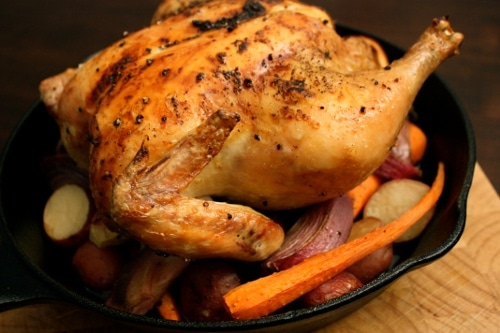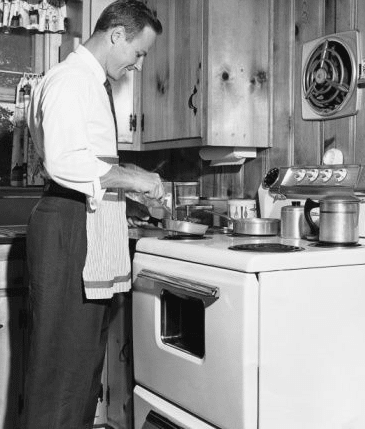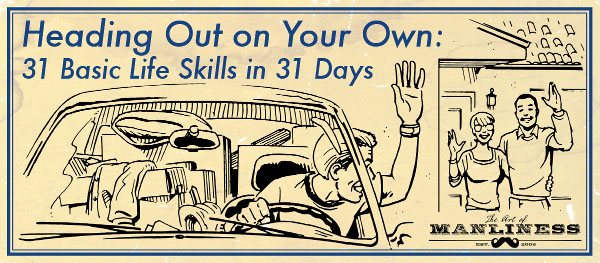The people have spoken. A big thanks to all of you for the outstanding comments from last month’s post. An overwhelming majority responded that you would like more information regarding knives and knife skills. Ask and you shall receive.
I’ll save you from a long personal intro this time around and get straight to the point. Cut and dry (pun intended). However, I should mention that some of your comments and questions have already been addressed in my prior articles. I thought I would start out this month by providing links from the very beginning.
Take Back the Kitchen: 3 Great Meals to Impress a Date
The Perfect Valentine’s Day (Special Occasion) Menu
The Other Side of Grilling
Meals for the Bachelor: 5 Simple, One Skillet Meals
5 Stick to Your Rib Soups from Around the Country
Kitchen Fundamentals: How to Make a Whole Roasted Chicken
Kitchen Knives 101
Dog : Man :: Knife : Chef.
If you are having trouble understanding the analogy above, allow me. A good knife is a chef’s best friend. Whether used to delicately slice paper thin vegetables, to crush through bones and tendons, or simply to remind those around you to “get out of your kitchen,” knives are an essential kitchen tool–the most essential tool, I might argue.
Personally, I use one knife about 95% of the time: an 8-inch top quality chef’s knife. Don’t let the high price tag scare you. A well-crafted knife lasts for decades, and it’s worth the investment. Because I tend to be a minimalist in the kitchen, I’m always looking for tools that can accomplish several different tasks in one. I’d rather have one expensive knife that can complete 4 – 5 different tasks than invest in an individual tool for each job. Besides, there’s less cleanup my way.
So, how do you choose a good knife? Well, if the chef’s knife in your $60 wood block set is letting you down, there’s probably a good reason.
You get what you pay for.
In cooking, I always say that great meals start with using great ingredients. That philosophy is also true for knives–it’s all about material. Top quality knives are forged using the highest quality of finely polished stainless steel. Though other materials–including ceramic–have recently been introduced to the manufacturing process, stainless steel remains the preferred choice for most chefs. The weight or feel of the knife should also reflect quality. There should be no joints between the blade and the handle, i.e. seamless integration. The handle should allow for a secure grip, while also being comfortable for use over time. Regarding the surface, the overall appearance of the blade should be smooth and highly polished, serving as sign that the knife is resistant to rust and corrosion. And finally, the cutting edge should retain its sharpness over time. Of course, the last quality is the most subjective to both use and care.
Knives should always be kept as sharp as possible–more on this later. Working with a dull knife causes one to use more pressure, which increases the risk of the blade slipping while cutting. I prefer to always work on a wood or plastic cutting board. These types of surfaces give to the blade versus a glass or ceramic surface, which helps retain the edge. Of course, you always want to cut away from your body. Like most of my more expensive cookware, I prefer to hand wash and dry my knives instead of using the dishwasher. This ensures that the knives are not damaged should they come in contact with other objects. Lastly, always store knives in a knife block or secure tray when not in use.
Though my chef’s knife is my work horse, there are other types of knives and tools that I find particularly useful. From left to right, they are as follows.
The Knives Every Man Should Have in His Kitchen

In order from left to right: Steel, Serrated Utility Knife, Cleaver, Chef’s Knife, Filet Knife, Paring Knife
Steel – a tool used to sharpen knives.
Serrated Utility Knife – used for slicing bread, meats, or other foods with a hard crust or outer skin. Also great for cutting juicy or soft vegetables such as tomatoes.
Cleaver – used to de-bone or butcher larger cuts of meat where more weight and less precision is needed.
Chef’s Knife – the most used and versatile knife in the kitchen. Used for slicing, dicing, chopping or de-boning smaller cuts of meat.
Filet Knife – a sharp and slim bladed knife for filleting fish or removing and trimming fat and silver skin from tenderloins.
Paring Knife – a small, versatile knife used to peel, cut, or clean fruits and vegetables.
Honing Kitchen Knives
Depending on the amount and type of use, I recommend having your blades professionally sharpened every 12 – 18 months. Many of your local kitchen supply stores offer this service for $5 – $7 per knife to restore the original edge. Of course, you can always invest in an electronic sharpener to keep at home. Between uses, you can keep your blade sharp by using a sharpening steel. Keep in mind that serrated knives should maintain their edge and should not be sharpened.

Step 1: Hold the steel and knife in opposing hands, firmly gripping the knife and holding the steel down, away from the body.
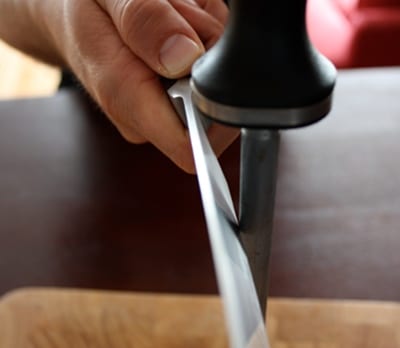
Step 2: Place the heel edge of the knife at a 20 degree angle from the steel.

Step 3: Pull the knife down the steel, from heel to tip, maintaining an angle of 20 degrees.
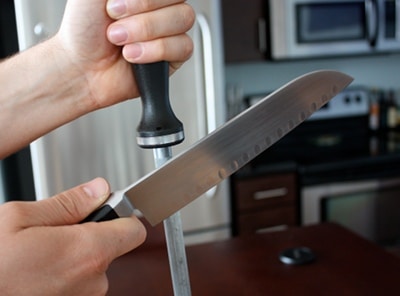
Step 4: Repeat this procedure 4 – 6 times, alternating between the left and right side of the blade.
Editor’s Note: We made a few corrections based on your feedback. Thanks!
Kitchen Fundamentals Series:
How to Make a Whole Roasted Chicken
The 6 Knives Every Man Should Have in His Kitchen
Basic Knife Skills



